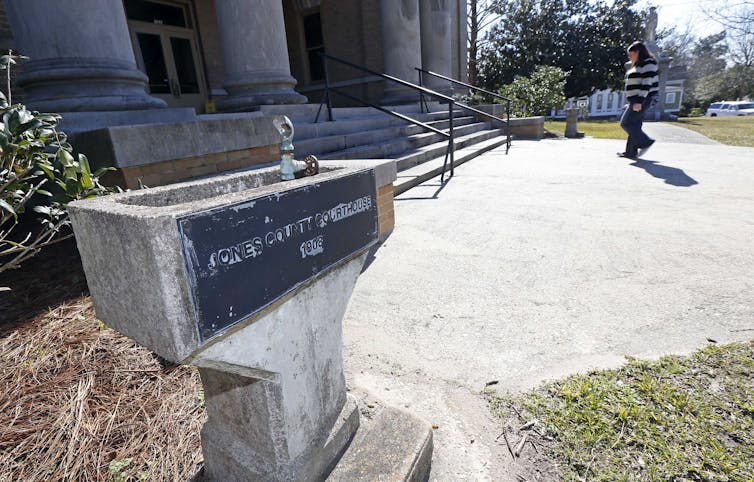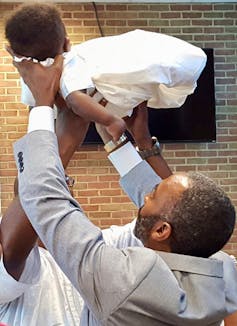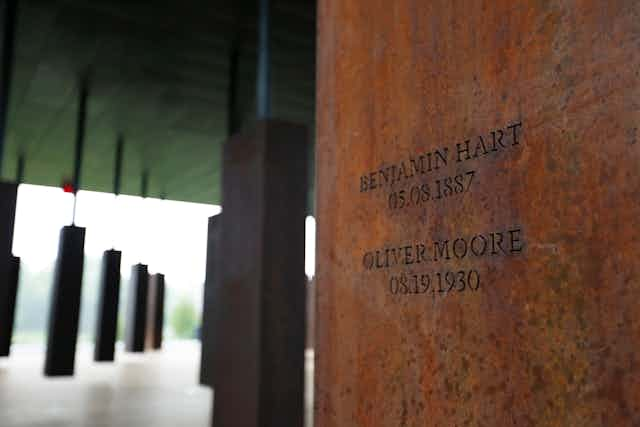Do you smell it? That foul odor that floats in the air, when something you thought was dead is unearthed.
That’s the smell of ole man Jim Crow crawling back into our daily lives.
One of the most horrendous and abhorrent forms of Jim Crow violence – the racial caste system that operated between 1877 and the mid-1960s, primarily in Southern states – was the publicly sanctioned use of “racial terror lynchings.” These killings were perpetrated by those who enjoyed the protection of white supremacist social policies designed to maintain strict control of African-Americans through the systemic use of terror.
Documenting those lynchings is the goal of the National Memorial for Peace and Justice, or NMPJ, which opened on April 26, 2018.
But our question is: How do memorials to that dehumanizing violence help the African-American descendants of such treatment heal from their history?
History as trauma
Jim Crow was grounded in the lie of Black inferiority. Dismantling the impacts of that lie on individuals and communities has been an ongoing effort of members of the Association of Black Psychologists, of which we both are members. The organization was founded almost 50 years ago so that “psychologists of African descent … can assist in solving problems of Black communities and other ethnic groups.”
As psychologists, we ask the complex question: Can memorials to a dehumanizing and traumatizing history, the Jim Crow history, provide a path to restorative justice, psychologically, socially and politically?
For African-Americans, history and trauma aren’t just in the past. Indeed, it would be simpler to help our communities heal if Jim Crow were but a memory.
In the last 50 years or so, black Americans thought ole Jim Crow had died. But really, ole man Crow had simply gone to finishing school and emerged as James Crow, Esq. He had polished up his language and was operating in an alleged system of diversity and multiculturalism, soft-selling his system of exclusivity as “traditions.”
Those traditions were called “states’ rights” and “customs,” “school choice” and “law and order.” Then there are the Jim Crow practices that disproportionately target Black Americans: mass incarceration, police brutality and the war on drugs.

One of the clearest examples of ole man Jim Crow resurfacing has been the documented public assaults and assassinations of Black bodies during the last 10 years. Men, women and children of African ancestry are being beaten, bruised and executed by police across the country simply for being Black and alive. Our communities experience direct and vicarious trauma every day.
Now, to this daily terror, add historical trauma for Black Americans.
Historical trauma is the cumulative phenomenon where those who never directly experienced trauma (enslavement, rape, lynchings, murder) can still exhibit signs and symptoms of the trauma.
That historical trauma can be observed in African-Americans’ unresolved grief, expressed as depression and despair and their harboring of unexplained anger, expressed as aggression and rage. Often they internalize oppression by accepting the lie of inferiority, which can then lead to self-loathing.
This historical trauma must be addressed. It functions as a persistent sickness, a deadly virus – in the family, in the African-American community and in the larger society.
Memory as medicine
The establishment of the National Memorial for Peace and Justice begins a long-awaited process of healing from the unspeakable and unacknowledged acts in our history, whose echoes can still be heard today. It is an excellent example of one step towards the process of healing historical trauma for persons of African ancestry.
By accurately documenting the gravity of the massacres, the NMPJ names the nameless, counts the uncounted and frees the victims, who were savagely desecrated, from the perpetrators of the atrocities of racial terror lynching.
The NMPJ was established in an effort to promote social justice that can be liberating and validating to African-American people. Its mission aligns with that of the Association of Black Psychologists, which is the “liberation of the African Mind, empowerment of the African Character, and enlivenment and illumination of the African Spirit” – all with the goal of restoring humanity, promoting optimal functioning and insuring psychological wellness.
Most trauma experts recognize that the restoration of memory is healing. Developing a story in which the victim is held blameless from the infliction of abuse is essential for rebuilding a sense of independence and self efficacy.
In our work as psychologists, we understand that helping our clients manifest resilient, powerful stories can help them negotiate the distress of historical trauma.
Focusing on strengths can help descendant African-Americans learn to overcome challenges and tap into reservoirs of strength and self-determination. For example, understanding that many of the African-Americans represented in the NMPJ were killed because they stood up for injustice, had the strength to resist and fought for the freedoms of subsequent generations can be healing.
Stories that heal
In an earlier work, we advanced an argument that there is a set of general healing goals that are important to consider for persons of African ancestry. Those healing goals, taken together, allow us to reconstruct understandings our community and ourselves.

This is done through helping us take back our individual and collective identities and stories, especially those that replicate and reflect our true and righteous African heritage. The goals also allow us to restore our spirits, sense of self, sense of wonderment and potential.
We then can recognize the divine within, as well as promote our community members’ interdependence and interconnectedness – truly embodying the African proverb, “I am because we are and since we are, therefore I am.”
Recently, scholar Shawn Ginwright argued that addressing the ongoing exposure of African-Americans to dehumanizing experiences calls for a shift to healing-centered engagement instead of trauma-informed care. That departure shifts the focus from “what’s wrong with you” to “what’s right with you.”
For example, rather than locating the trauma within the individual, a healing-centered engagement would address the issues that created the trauma in the first place, and would view the individual holistically, highlighting strengths and resilience.
The National Memorial for Peace and Justice helps restore memories that demonstrate the violence perpetrated against black people during the horrific epoch of publicly sanctioned lynching was not the fault of the victims and survivors of African ancestry.
The memorial defies the lie of Black inferiority.
The danger of accurately retelling the horrific stories of people of African ancestry in the U.S. is that it may create new trauma. Pairing accurate histories with healing-centered engagement can limit this risk.
For example, the Association of Black Psychologists, in partnership with the Community Healing Network, conducts Emotional Emancipation Circles. These national self-help groups focus on overcoming the lie of black inferiority and the emotional legacies of enslavement and racism.
We believe that the restorative memories developed in public spaces like the National Memorial for Peace and Justice create a shared story that can inoculate African-Americans from ongoing dehumanization.

